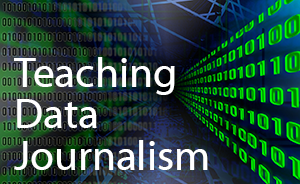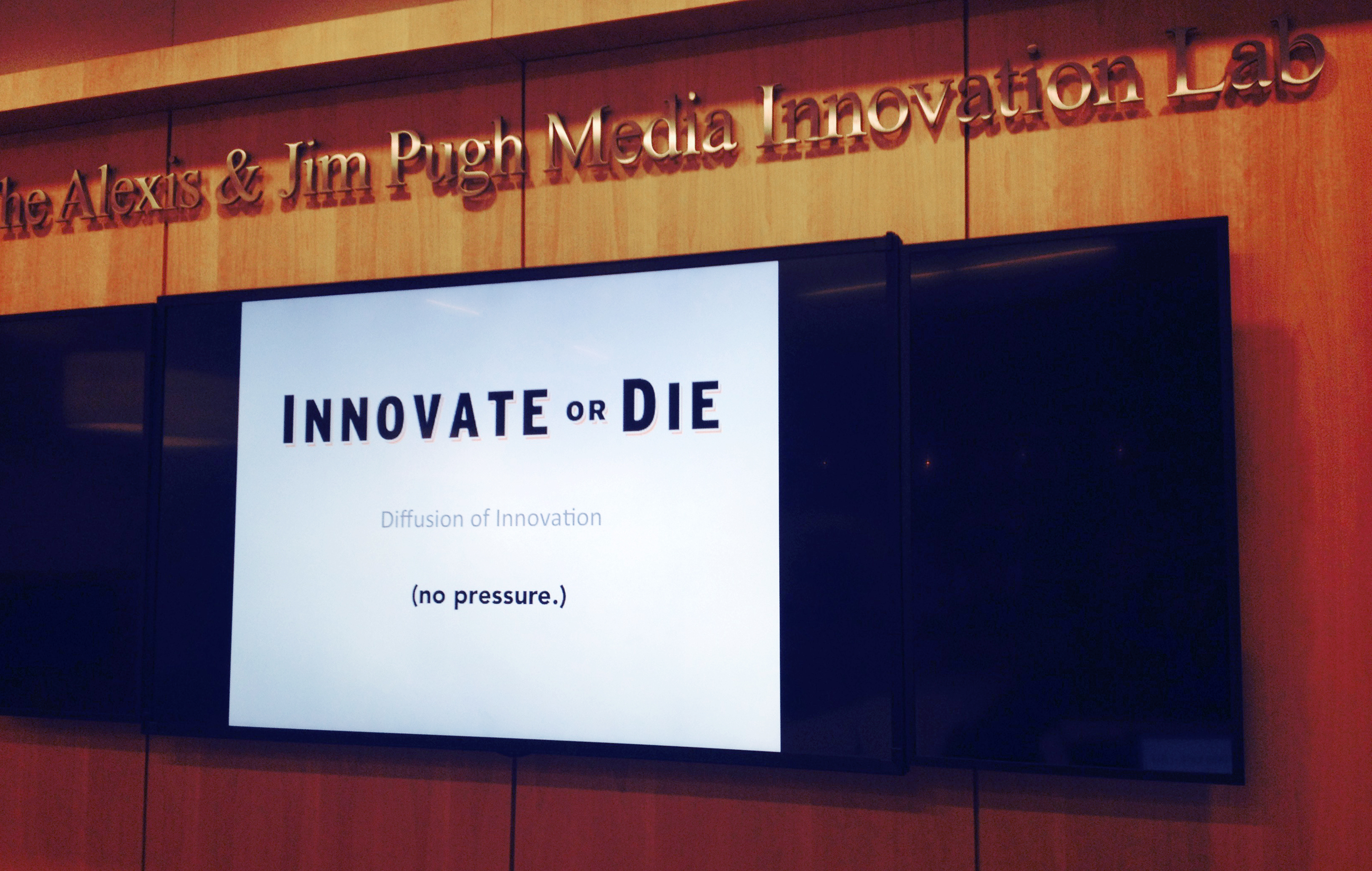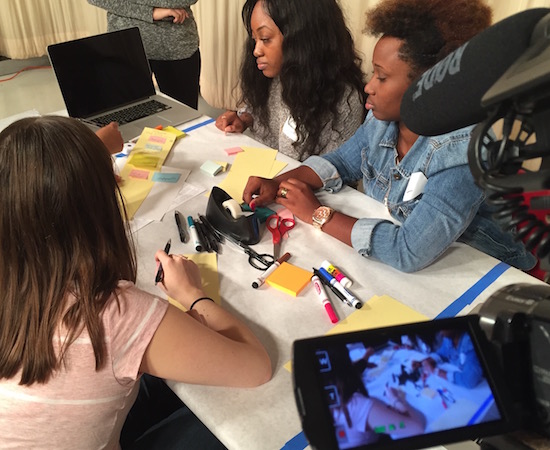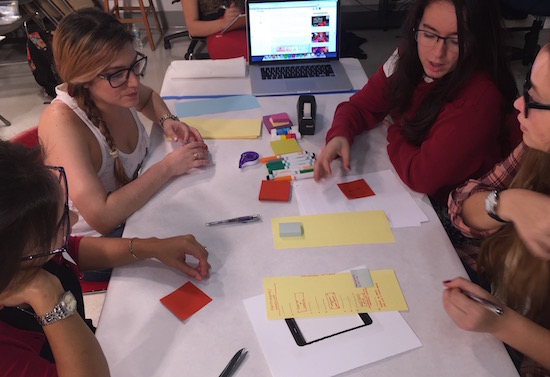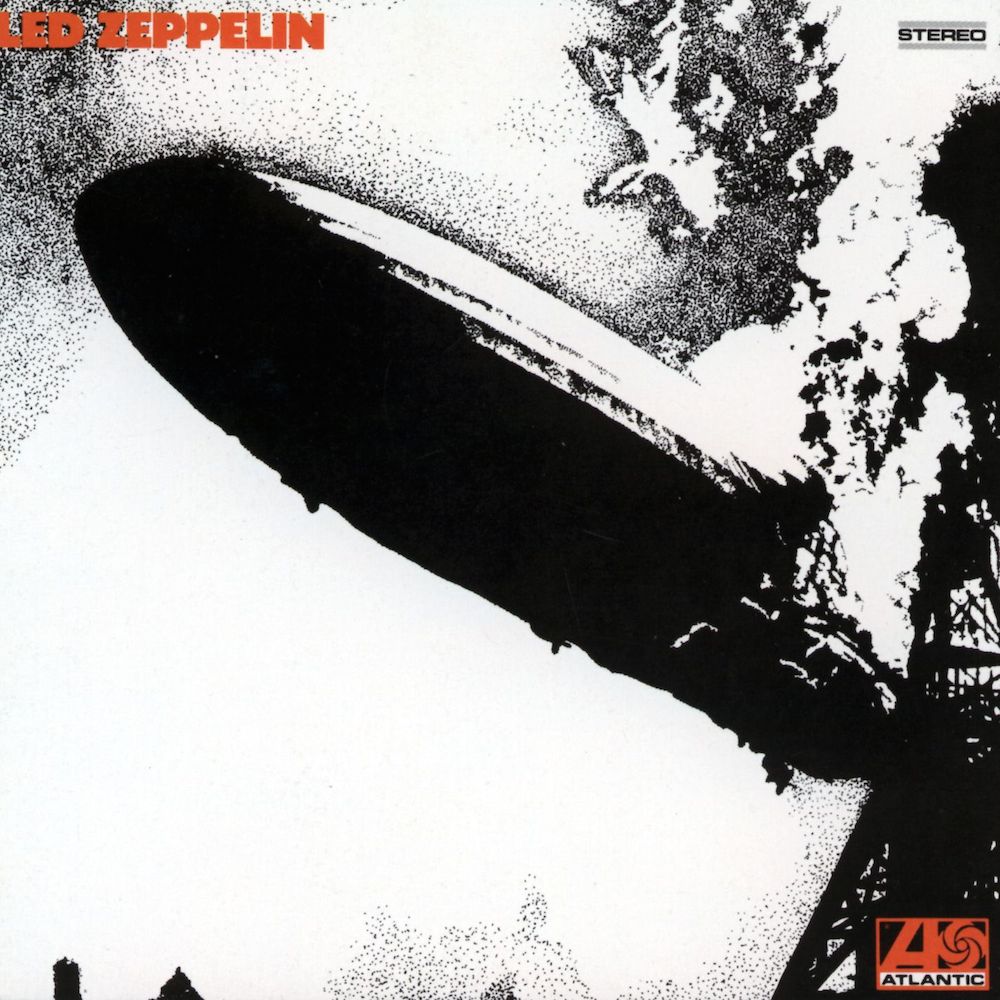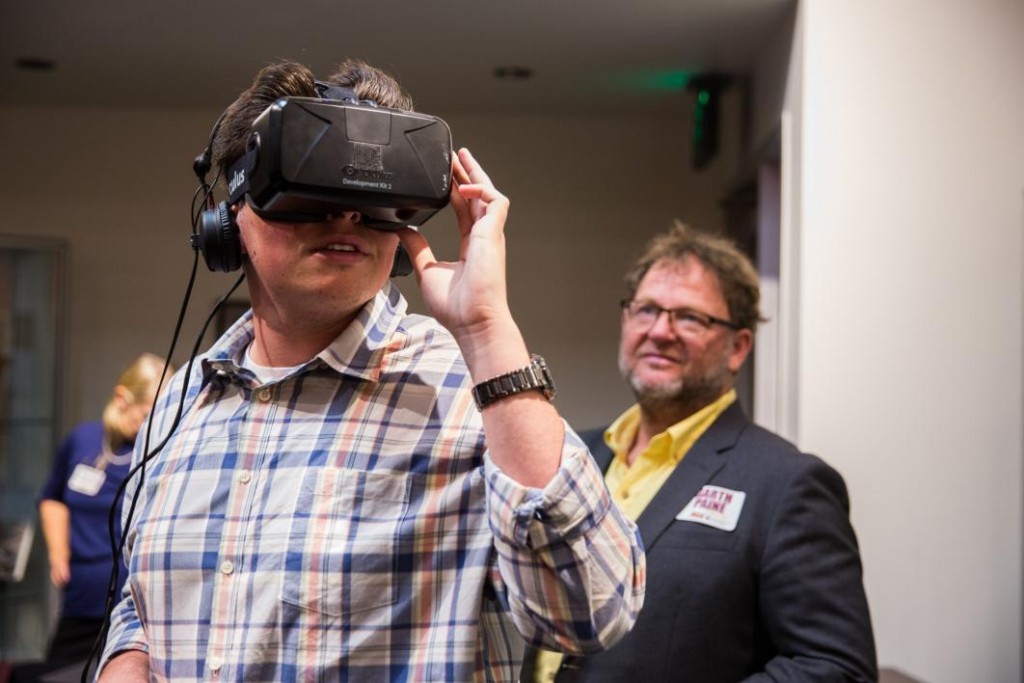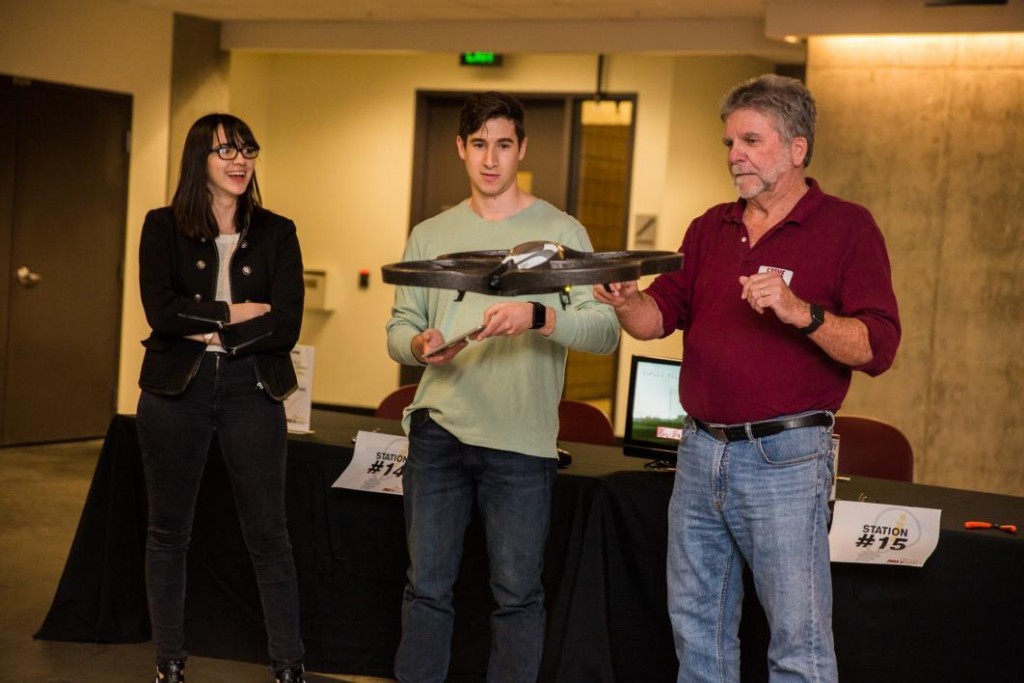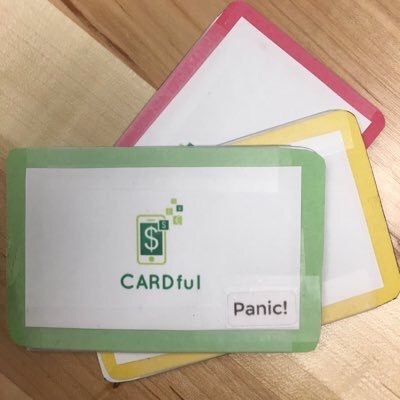The Online News Association is now accepting applications for the second round in its Challenge Fund to help stimulate journalism curriculum innovations through live news experiments. Supported by the Democracy Fund and the Ethics and Excellence in Journalism, Knight, McCormick and Rita Allen foundations, the Challenge Fund offers $35,000 micro-grants to journalism programs willing to explore the possibilities of new and collaborative approaches.
Schools currently in the midst of projects funded in the first round of the fund gave us updates on what they’re doing, what they’re learning and where they’re headed.
Arizona State University
Rebecca Blatt, Public Insight Network Bureau Chief
rebecca.blatt@asu.edu
Project: Finding the Middle Ground
Description: As part of this year’s News21 investigative report on gun rights and regulations, we engaged hundreds of people across the country throughout the reporting process and are evaluating the impact that engagement had on reporting and the lives of participants.
What’s the most important thing you’ve learned so far in your project? Why?
We’ve learned that many people are willing to share their perspectives on controversial topics like guns if they’re given an opportunity to do so in a supportive environment. We hosted a six-week online discussion about gun issues with 34 people from across the country, many of whom said they didn’t feel comfortable talking about guns with their friends and relatives, but they were willing to have an honest conversation in a private group moderated by one of our student journalists. This makes us hopeful about opportunities to engage other audiences in open dialogue to deepen understanding among journalists and community members.
What piece of advice do you have for future grantees or others trying live news experiments?
Assemble a strong team of partners who are excited to collaborate, develop a timeline for the project and stick to it. Our partners were all incredibly busy with other responsibilities, but we set out a list of milestones that kept us focused and accountable.
CUNY Graduate School of Journalism
Sandeep Junnarkar, Associate Professor and Director of Interactive Journalism
sandeep.junnarkar@journalism.cuny.edu
Jere Hester, Director of the NYC News Service
jere.hester@journalism.cuny.edu
Project: Stop the Mold
![Microsoft Word - Document1]() Description: Teaming with the NY Daily News, we’ll test high- and low-tech approaches to crowd-sourcing to engage New Yorkers who are not hyper-connected to news. Working with public housing tenants, we’ll quantify the scope of a pressing mold problem, work with tenants to test for mold and track NYC’s court-mandated cleanup
Description: Teaming with the NY Daily News, we’ll test high- and low-tech approaches to crowd-sourcing to engage New Yorkers who are not hyper-connected to news. Working with public housing tenants, we’ll quantify the scope of a pressing mold problem, work with tenants to test for mold and track NYC’s court-mandated cleanup
What’s the most important thing you’ve learned so far in your project? Why?
We knew going in that we were trying to reach a segment of the population that has good reason to be suspicious of promises from authority figures and to be skeptical of the media. What we underestimated was the level of fear some tenants have about speaking out, a fear that extends to possibly losing their apartments or being otherwise retaliated against by management or even management allies within some developments. We’ve addressed this by redoubling our efforts to connect with tenant leaders, community groups, etc., to help build trust. We’ve discovered that the mold problem and related health problems – at least in the developments we’ve initially targeted — appear to be even worse than we anticipated.
How are students or your community benefiting from your project?
Each community member is getting to see that they are not isolated in facing the mold epidemic because we are showcasing many voices on our site. City council members are also taking notice and starting to tweet our efforts, which we hope will lead to action. Students are learning, through trial and error, the journalism of engagement and collaboration. That collaboration plays out on several levels: with tenants, community leaders and other stakeholders; with players in different departments of a major news organization; with one another as a team charged with a challenge as exciting as it is daunting. Our students were told from the start that their ideas are not only valued but necessary to drive this project.
What piece of advice do you have for future grantees or others trying live news experiments?
Carefully weigh the differences between partnering with a small news organization and a larger news organization. They each have their advantages and disadvantages. For example, smaller news partners want more content (and more frequently); they have less less hierarchy so big decisions can be made in a more timely way. But their reach might be less developed in terms of drawing a large audience, which might lead to less crowdsourced information. Having a bigger news partner involves running requests up the chain of command and can delay decisions. But you are able to entice a community to participate because they understand the power and impact of a larger publication’s coverage.
Florida International University
Robert Gutsche, Assistant Professor
rgutsche@fiu.edu
Project: Sea Level Rise: South Florida
Description: Our website, eyesontherise.org, aims to raise awareness and to educate South Florida communities about the impact, challenges and threats of sea level rise to create possible solutions for a sustainable future.
What’s the most important thing you’ve learned so far in your project? Why?
We’ve changed our ideas of audience, broadening it beyond traditional ideas of legacy and even new media, to include our students, community partners, and those who engage with this project outside of news. While we are focused on creating journalism for programming audiences, we are also interested in the civic nature of news-making and the audiences who come to learn about science and communication processes inherent in public discussion of sea level rise.
What piece of advice do you have for future grantees or others trying live news experiments?
Grantees should continue to help expand discussion about how such work is represented in tenure and promotion policies, the organizational challenges, politics and communication related to taking on complex social issues, and the role of program evaluation when dealing with so much experimentation.
![Document1]()
San Diego State University
Amy Schmitz Weiss, Associate Professor
aschmitz@mail.sdsu.edu
Project: What’s in the Air?
Description: This is a collaborative between journalism and science students from San Diego State University along with inewsource, a nonprofit news organization, to experiment with the concept of using electronic sensors to test air quality in San Diego in an effort to help the public be more informed about pollution and its impact on the city.
What’s the most important thing you’ve learned so far in your project? Why?
We have learned a lot about the science of sensors and how gas and particulate matter sensors differ from one manufacturer to the next. We are doing beta tests now to identify the best prototype to take into the community. It’s been a constant learning experience and a fun one to explore these nuances as we look at air quality.
How are students and/or your community benefiting from your project?
Students will be enrolling in a special class next spring and the community will be able to get involved once we have our air quality sensor prototype that they can build for themselves and deploy in their own backyards.
What piece of advice do you have for future grantees or others trying live news experiments?
Be specific about what you would like to explore, build or create. Make sure to have several partners or collaborators — such as other departments on campus, nonprofits in the community, nonprofit news organizations, and the general community involved. Be agile. Allow room for changes in your plan/project. As things will change and when they do, you can easily pivot.
San Francisco State University
Jesse Garnier, Assistant Professor
jesse@sfbay.ca
Project: Newspoints
Description: We are building Newspoints, a smartphone app that guides student journalists through multimedia reporting with on-screen prompts and guidance. We will measure the effectiveness of the tool by deploying student interns and measuring the speed, accuracy and thoroughness of their reporting.
How are students and/or your community benefiting from your project?
Newspoints is scheduled to deploy to our community partner in January 2015. So far, a series of meetings and discussions have shaped the app’s development and an emerging editorial plan. Multimedia editorial coverage will begin after deployment and will benefit the Mission District by sharing stories that accurately and compassionately cover a community.
What piece of advice do you have for future grantees or others trying live news experiments?
Your idea is only as strong as your team!
Texas State University
Cindy Royal, Associate Professor
croyal@txstate.edu
Project: TexasMusicViz
Description: TexasMusicViz combines data visualization and application development to tell the important stories as of a community related to music: its history, culture and interaction.
What’s the most important thing you’ve learned so far in your project? Why?
Programming and data skills are vast and complicated to teach and learn. It will take more than one course to provide students with the skills they need to be effective interactive storytellers. We are proposing a major that will provide a digitally immersive experience for students who want to focus on these skills. Cross-department collaborations are possible, but they require compatibility of goals and communication. The community benefits by having more news experiences that are interactive, personalized and meaningful.
How are students and/or your community benefiting from your project?
Students are very excited to learn these skills. They recognize the importance of programming and data to storytelling and want to use them in their careers. This project has set many of them on a path that they wish to continue.
What piece of advice do you have for future grantees or others trying live news experiments?
Don’t be afraid to try out new ideas as experiments. Push yourself to learn new skills for the benefit of your students. Seek feedback, learn and adjust. Innovation happens in small increments or innovations.
Georgia State University
David Armstrong, Director of the Department of Communication
david.armstrong@georgianewslab.org
Project: Georgia News Lab
![Microsoft Word - Document1]()
Description: Four university journalism programs, including two HBCU’s, are teaming with two major news outlets to train a new generation of investigative reporters and help diversify newsrooms.
What’s the most important thing you’ve learned so far in your project? Why?
Collaboration is the future of investigative reporting. Everybody benefits: students, universities, news outlets and the public.
How are students and/or your community benefiting from your project?
Students are working with professional journalists, learning skills they could not obtain at their home universities, and the public gains from access to stories that could not be done without students doing the legwork.
What piece of advice do you have for future grantees or others trying live news experiments?
Find great partners. Fill in the gaps. Do what’s not being done anymore that needs to be.
Missouri School of Journalism
Roger Gafke, Director of Program Development
gafker@rjionline.org
Project: The Town Square: Social-Media Driven Public Affairs Programming
Description: Using intense social media in a traditional commercial television station to deeply explore public affairs topics.
What’s the most important thing you’ve learned so far in your project? Why?
We have learned that a commercial television station can again provide serious public affairs programming by using social media as a reporting and promotion tool.
How are students and/or your community benefiting from your project?
Students are learning by doing (The Missouri Method) social media, sending out messages before, during and after the on-air presentation of a public affairs topic. They engage in conversations with members of the community. They discover new sources for the traditional reporting process. These topics are aired during 20-minutes of the 12 noon newscast.
University of New Mexico
Michael Marcotte, Visiting Associate Professor
mm@mikemarcotte.com
Project: The New Mexico News Port
Description: A collaboration hub for shared public service journalism in New Mexico, based at UNM, Albuquerque.
What’s the most important thing you’ve learned so far in your project? Why?
Students, faculty, professional journalists and donors all want to see growth and success in strong, ethical journalism … but many are just too busy surviving the present to go about creating change for the future. That’s why people love our project. It takes on the time and risk of change.
How are students and/or your community benefiting from your project?
Students are growing tremendously in experience, skills and confidence. The community is getting more coverage than before, from more perspectives.
What piece of advice do you have for future grantees or others trying live news experiments?
Roll up your sleeves and go for it. A lot can happen quickly. In fact, the urgency is helpful. There will be discomfort, some loss of total control, some stumbles… but it is a small price to pay for the new vision and the new opportunities you can unlock.
![Microsoft Word - Document1]()
University of Wisconsin-Madison
Kathleen Bartzen Culver, Assistant Professor
kbculver@wisc.edu
Project: The Confluence
Description: Reporting project with the Wisconsin Center for Investigative Journalism to cover urgent water supply and quality issues in the state.
What’s the most important thing you’ve learned so far in your project? Why?
In addition to finding out exactly how many gallons are in all the Wisconsin Dells waterparks (16 million), we’ve learned that project-based reporting on a single topic is easier than daily reporting. Almost all our participating classes are packaging multimedia pieces rather than getting out to cover meetings or events.
How are students and/or your community benefiting from your project?
The most important benefit: Giving everyone the freedom to try and fail without fear. We’re opening up minds to the very idea of experimentation.
What piece of advice do you have for future grantees or others trying live news experiments?
Both you and your media partner should be in a constant quest to keep each other honest about deadlines and progress.
University of Illinois
Brant Houston, Professor and Knight Chair of Investigative Reporting
brant.houston@gmail.com
Project: Intersections
Description: We are creating a portal that makes it easier to search and analyze social media content for a specific geographic area.
What’s the most important thing you’ve learned so far in your project? Why?
We have found much more intriguing content — events and issues — through our archiving and review of social media, specifically Facebook and Twitter, than we expected. It turns out that the the commonly used digital tools for searching social media do not overcome some of the challenges of collecting and archiving content from Facebook and Twitter for a particular geographic area.
How are students and/or your community benefiting from your project?
We have just finished the initial stage of our project and students are beginning to look for information on specific topics. We will encourage community use in the new year.
What piece of advice do you have for future grantees or others trying live news experiments?
Patience. It takes time to develop new archiving and analytic tools for live news experiments and to learn how to use them effectively.
University of Oklahoma
David Craig, Associate Dean and Professor
dcraig@ou.edu
Project: Talk With Us: Poverty in Oklahoma City Neighborhoods
Description: The project is using mobile video, in tandem with GIS data, to report on and create a conversation about poverty in Oklahoma City between residents of low-income neighborhoods and area leaders.
What’s the most important thing you’ve learned so far in your project? Why?
A successful collaboration with a media partner takes careful upfront planning. Our partner, Oklahoma Watch, helped the project tremendously by doing preliminary test interviews with mobile video in the neighborhoods over the summer and developing protocols for students to help them with matters such as sound quality and interaction with residents.
How are students and/or your community benefiting from your project?
As one instructor put it, the project has helped students learn “how to interact with a variety of people and situations. It has pushed student out of their comfort zone and made them mature in their craft in a much faster way than they normally would just interviewing people on campus.”
What piece of advice do you have for future grantees or others trying live news experiments?
Include a test/trial phase the summer before the project begins on any techniques that haven’t been used in the participating classes before or are being used in different settings.
Visit the Challenge Fund directly for more information on applying for the second round. Any of the grantees above with an email address linked are willing to talk with potential applicants and offer more about their proposals and what is working and floundering.
Meagan Doll is a junior at the University of Wisconsin-Madison studying journalism. She is an intern for the EducationShift section at PBS MediaShift.



















